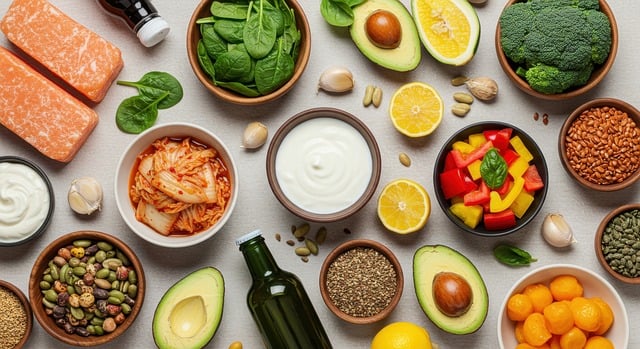Contact Us 720-964-1335 or 901-675-6125
5 Surprising Carbs That Actually Help Balance Blood Sugar

Carbohydrates (carbs) often get a bad reputation, especially for women over 40 who are focused on weight management and hormonal health. Many diet trends push the idea that carbs are the enemy, leading to cravings, weight gain, and energy crashes. But here’s the truth: not all carbs are created equal. In fact, the right carbohydrates don’t just provide energy. They also help stabilize blood sugar, prevent insulin resistance, and support long-term wellness.
As a board-certified nurse practitioner and certified holistic nutrition weight loss coach, I’ve seen firsthand how choosing the right carbs can make or break a client’s progress. Instead of avoiding carbs altogether, I guide women toward nutrient-rich, fiber-filled foods that fuel the body without spiking blood sugar. The key is quality over quantity, and this means choosing whole, minimally processed carbs that work with your hormones and metabolism rather than against them. Here are five of my favorite go-to carbs for women over 40:
1. Quinoa
Quinoa is a gluten-free ancient grain that’s high in both fiber and protein. Unlike refined carbs that digest quickly, quinoa’s complex carbohydrates provide slow, steady energy. This means fewer energy crashes, less irritability, and fewer cravings.
Why it’s great: Quinoa’s balance of protein and carbs supports both blood sugar control and muscle health. Research shows that higher-fiber grains like quinoa can help improve insulin sensitivity and reduce post-meal blood sugar spikes (Gullón et al., 2020).
How to use it: Swap quinoa in for rice, add it to salads, or use it as the base for power bowls. You can also mix it into soups or stews for extra texture and nutrition.
2. Sweet Potatoes
Sweet potatoes are a vibrant, nutrient-packed carb that’s naturally high in fiber, beta-carotene, and potassium. Unlike refined starches such as white bread, sweet potatoes provide a slow release of glucose into the bloodstream, which helps avoid sugar highs and crashes.
Why it’s great: They’re satisfying, delicious, and help keep energy steady. Sweet potatoes are also linked to improved gut health due to their fiber content, which feeds beneficial gut bacteria (Ma et al., 2021).
How to use it: Try roasted wedges, mashed sweet potatoes, or baked sweet potato fries. For a quick lunch, top a roasted sweet potato with black beans, avocado, and salsa for a balanced, blood-sugar-friendly meal.
3. Lentils
These tiny legumes are a powerhouse of nutrition. Lentils are rich in soluble fiber and plant-based protein, making them excellent for stabilizing blood sugar and supporting digestive health.
Why it’s great: Lentils slow down digestion and reduce blood sugar spikes. A 2018 study found that replacing starchy side dishes with lentils significantly lowered post-meal blood sugar levels in adults (Zhu et al., 2018).
How to use it: Add lentils to soups, toss them into salads, or make lentil-based veggie burgers. They also make a hearty base for stews and curry dishes.
4. Oats
Oats are one of the best carbs for heart and metabolic health. They contain beta-glucan, a type of soluble fiber that slows glucose absorption and improves cholesterol levels.
Why it’s great: Oats promote satiety, improve cholesterol, and help with blood sugar balance. Regular oat consumption has been associated with reduced risk of type 2 diabetes and cardiovascular disease (Whitehead et al., 2022).
How to use it: Enjoy overnight oats, warm oatmeal, or oat-based smoothies. You can also blend oats into flour for homemade pancakes or muffins.
5. Berries
Berries are unique because they’re naturally sweet but lower on the glycemic index compared to many fruits. They’re also packed with fiber and antioxidants that fight inflammation and oxidative stress.
Why it’s great: They satisfy sweet cravings without causing insulin spikes. Research has shown that berries can improve insulin response and reduce oxidative stress, both of which support healthy aging (Basu et al., 2019).
How to use it: Snack on them fresh, add to Greek yogurt, or blend into smoothies. Frozen berries are just as nutritious and perfect for baking or tossing into oatmeal.
The Bigger Picture: Carbs & Women Over 40
For women over 40, balancing blood sugar isn’t just about avoiding desserts. It’s about creating a sustainable eating pattern that works with your changing metabolism and hormones. Estrogen decline during perimenopause and menopause can affect insulin sensitivity, making it easier for blood sugar to spike and harder to maintain a healthy weight. This is why choosing fiber-rich, whole-food carbs becomes even more important.
The right carbs can help you:
- Maintain steady energy throughout the day
- Reduce cravings that drive overeating
- Support gut health by feeding healthy bacteria
- Protect heart health by improving cholesterol and reducing inflammation
Instead of fearing carbs, focus on choosing the right ones —> whole, fiber-filled, and minimally processed. Pair them with protein and healthy fats to create meals that keep your metabolism steady and your energy high.
A Holistic Approach to Carbs & Wellness
Carbs don’t have to derail your weight loss or wellness journey. In fact, when chosen wisely, they can help you feel more satisfied, energized, and in control of your health. The secret lies in understanding your body’s unique needs after 40 and building balanced meals that support your hormones, metabolism, and overall well-being.
At Ample Health & Wellness, I help women over 40 create realistic, nourishing meal plans that support weight loss and hormone health—without cutting out foods you love. Learn more about my holistic weight loss program and grab a copy of my book, The Weight Is Over, at amplehealthandwellness.com.

References
- Basu, A., Nguyen, A., Betts, N. M., & Lyons, T. J. (2019). Strawberry as a functional food: An evidence-based review. Critical Reviews in Food Science and Nutrition, 59(6), 830–846. https://doi.org/10.1080/10408398.2018.1474190
- Gullón, B., Astray, G., Gullón, P., Tomasevic, I., & Lorenzo, J. M. (2020). Quinoa (Chenopodium quinoa Willd.) and its by-products as a new source of dietary fiber: Functional properties and physiological effects. Molecules, 25(3), 625. https://doi.org/10.3390/molecules25030625
- Ma, X., Sun, Q., Liu, J., & Qiu, S. (2021). Sweet potato dietary fiber regulates intestinal microbiota and improves lipid metabolism in rats fed a high-fat diet. Nutrients, 13(5), 1656. https://doi.org/10.3390/nu13051656
- Whitehead, A., Beck, E. J., Tosh, S., & Wolever, T. M. S. (2022). Cholesterol-lowering effects of oat β-glucan: A meta-analysis of randomized controlled trials. European Journal of Clinical Nutrition, 76(6), 789–799. https://doi.org/10.1038/s41430-021-01092-w
- Zhu, Y., Bo, Y., & Liu, Y. (2018). Consumption of whole grains and incidence of type 2 diabetes: A meta-analysis of cohort studies. European Journal of Epidemiology, 33(2), 131–144. https://doi.org/10.1007/s10654-017-0356-4
